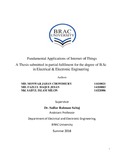| dc.contributor.advisor | Sabuj, Saifur Rahman | |
| dc.contributor.author | Chowdhury, Md. Monwar Jahan | |
| dc.contributor.author | Jesan, Md. Fazlul Haque | |
| dc.contributor.author | Milon, Md. Saiful Islam | |
| dc.date.accessioned | 2018-12-02T09:39:02Z | |
| dc.date.available | 2018-12-02T09:39:02Z | |
| dc.date.copyright | 2018 | |
| dc.date.issued | 2018 | |
| dc.identifier.other | ID 14110021 | |
| dc.identifier.other | ID 14310003 | |
| dc.identifier.other | ID 14321006 | |
| dc.identifier.uri | http://hdl.handle.net/10361/10930 | |
| dc.description | This thesis is submitted in partial fulfilment of the requirements for the degree of Bachelor of Science in Electrical and Electronic Engineering, 2018. | en_US |
| dc.description | Catalogued from PDF version of thesis. | |
| dc.description | Includes bibliographical references( page 57-62). | |
| dc.description.abstract | Presently there is a globally growing demand across all industries for small and portable electronic devices which feature Internet connectivity. This is largely due to their ease of use provided by robust interoperability and feasibility in almost any scenario. Internet of Things (IoT) can be a great tool to achieve this goal of connecting people and devices everywhere all the time. IoT is a network of various types of devices connected together to seamlessly data transfer without any computer or human interaction. IoT can be defined as a network consisting of many small sensor nodes whose main purpose is to collect data from surrounding environment and then forward to the base station. Firstly, we develop a theoretical model of physical layer of Wireless Sensor Network (WSN). Next, we derive the energy efficiency expression and solve the optimization problem of energy efficiency under the constraint of Packet Reception Rate (PRR). Two application perspective of IoT such as biomedical and smart home appliance has been proposed. Modeling of WSN using MATLAB to perform simulation of real human body have been analyzed. A model of smart juice maker has also proposed here which can be controlled from mobile apps. | en_US |
| dc.description.statementofresponsibility | Md. Monwar Jahan Chowdhury | |
| dc.description.statementofresponsibility | Md. Fazlul Haque Jesan. | |
| dc.description.statementofresponsibility | Md. Saiful Islam Milon | |
| dc.format.extent | 62 pages | |
| dc.language.iso | en | en_US |
| dc.publisher | BRAC University | en_US |
| dc.rights | BRAC University theses are protected by copyright. They may be viewed from this source for any purpose, but reproduction or distribution in any format is prohibited without written permission. | |
| dc.subject | Internet of Things | en_US |
| dc.subject | Wireless Sensor Network | en_US |
| dc.subject | MATLAB | en_US |
| dc.subject | Packet Reception Rate | en_US |
| dc.subject.lcsh | Internet of things | |
| dc.subject.lcsh | Embedded computer systems | |
| dc.subject.lcsh | Sensor networks | |
| dc.subject.lcsh | Intelligent buildings | |
| dc.subject.lcsh | Ubiquitous computing | |
| dc.title | Fundamental applications of Internet of Things | en_US |
| dc.type | Thesis | en_US |
| dc.contributor.department | Department of Electrical and Electronic Engineering, BRAC University | |
| dc.description.degree | B. Electrical and Electronic Engineering | |

